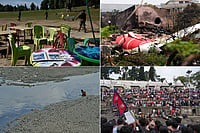Surrounded by mountains and a pristine view of the holy river Ganga, Mirzapur today is an amalgam of its past. It is known for its unique brass work, which is not likely to be found anywhere else in the world. And, it is also known for its handwoven carpets – the making of which is a tradition that has been passed down since the Mughal era. Today, Mirzapur is a land that not only preserves its past and its crafts but also embraces the present with the use of modern technology.
Take, for instance, the Ojhala Bridge which connects two cities – Mirzapur and Vindhyachal. Constructed above the river Ojhala, the bridge was built in the 18th century and is a brilliant piece of modern architecture. It provides transportation to vendors and gives them a place to rest as well.
The Namami Gange Project aims at making rivers like Ojhala and Ganga pristine. It has set up Uttar Pradesh’s first Faecal Sludge Treatment Plant (FSTP), based in Chunar. The functioning of this plant is simple. A total of 6,000 houses are present in the region, and when the septic tank or community toilet tanks get filled, people release it either on open land or water bodies. To keep water bodies clean and healthy, the plant, through an anaerobic process, disposes of the waste without the use of electricity or any mechanical tools. Instead, the entire process is done with the help of gravity.

***
Just 63 kilometres away from Mirzapur is the iconic yet vibrant ancient city of Varanasi. For some, it is Kashi whereas, for others, it is Banaras. Built on the shores of the Ganga, the city dates back to the 11th century BC. Banaras has successfully preserved its past – its art, culture and museums – as well as the Ganga, the heart of the city.
Banaras is often considered the holiest of all cities located on the banks of the river Ganga. Along the shores of the divine river, one feels free. The ghats and boats provide shelter – and it is here that one can appreciate the magnificence of the holy river.

The city’s drainage system was once highly commendable. The Shahi nala (or gutter) was constructed during the British era. Work on it began in 1879 and was fully completed in 1890. Seven-and-a-half kilometres in length and 2.4 metres in diameter, it had a brick lining and was as deep as 15 metres. As a matter of fact, the nala possessed sufficient space for elephants and horses to pass over it.
However, over the next 130 years, it slowly started to age. It became filled with stones and pebbles, and some of its walls were destroyed. This is where the Namami Gange Project took the initiative to clean the Shahi nala and improve the quality of the Ganga.
Initially, the gutter was connected with the different ghats and used to open into the Ganga. To put an end to this process, a plant in Dinapur was built. The plant is self-sufficient, as the operational electricity is generated through biogas produced through processing sewage. Moreover, this particular project also prevents 80 other nalas from flowing into the Ganga. That is another essential step to keep the river clean.

***
Clearly, in Mirzapur and Varanasi, the Ganga not only imparts cultural and historical significance and identities, it also provides employment to hundreds of people who act as the guardians of the river, ensuring that it stays around for generations to come. One hopes that the Namami Gange Project will continue to be the guiding light that it has become, when it comes to preserving the holiest of rivers in India.





















